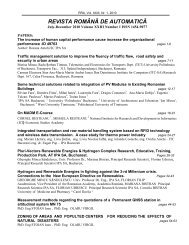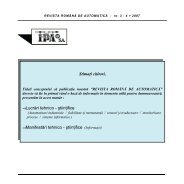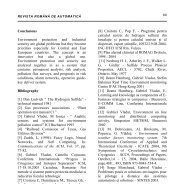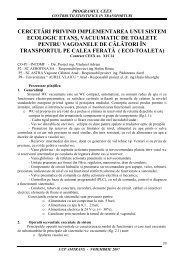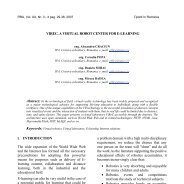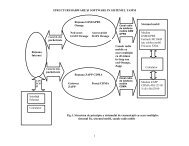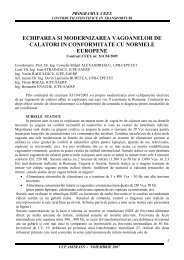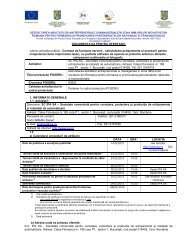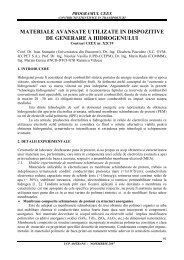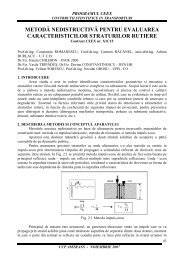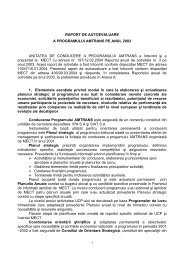REVISTA ROMÃNÄ DE AUTOMATICÄ - IPA SA
REVISTA ROMÃNÄ DE AUTOMATICÄ - IPA SA
REVISTA ROMÃNÄ DE AUTOMATICÄ - IPA SA
You also want an ePaper? Increase the reach of your titles
YUMPU automatically turns print PDFs into web optimized ePapers that Google loves.
<strong>REVISTA</strong> ROMÂNĂ <strong>DE</strong> AUTOMATICĂ<br />
21<br />
Counter-flow Drum Mix Plants<br />
Figure 3 shows a counter-flow drum mix<br />
plant. In this type of plant, the material flow<br />
in the drum is opposite or counter-flow to the<br />
direction of exhaust gases. In addition, the<br />
liquid asphalt cement mixing zone is located<br />
behind the burner flame zone so as to remove<br />
the materials from direct contact with hot<br />
exhaust gases. Liquid asphalt cement flow is<br />
controlled by a variable flow pump which is<br />
electronically linked to the virgin aggregate<br />
and RAP weigh scales. It is injected into the<br />
mixing zone along with any RAP and<br />
particulate matter from primary and<br />
secondary collectors. Because the liquid<br />
asphalt cement, virgin aggregate, and RAP<br />
are mixed in a zone removed from the<br />
exhaust gas stream, counter-flow drum mix<br />
plants will likely have organic emissions<br />
(gaseous and liquid aerosol) that are lower<br />
than parallel flow drum mix plants. However,<br />
the available data are insufficient to discern<br />
any differences in emissions that result from<br />
differences in the two processes. A counterflow<br />
drum mix plant can normally process<br />
RAP at ratios up to 50% with little or no<br />
observed effect upon emissions.<br />
Something about the recycle processes<br />
In recent years, the use of RAP has been<br />
initiated in the HMA industry. Reclaimed<br />
asphalt pavement significantly reduces the<br />
amount of virgin rock and asphalt cement<br />
needed to produce HMA. In the reclamation<br />
process, old asphalt pavement is removed<br />
from the road base. This material is then<br />
transported to the plant, and is crushed and<br />
screened to the appropriate size for further<br />
processing. The paving material is then<br />
heated and mixed with new aggregate (if<br />
applicable), and the proper amount of new<br />
asphalt cement is added to produce HMA that<br />
meets the required quality specifications.<br />
III. EMISSIONS AND CONTROLS<br />
Emissions from HMA plants may be divided<br />
into ducted production emissions, preproduction<br />
fugitive dust emissions, and other<br />
production-related fugitive emissions. Pre-<br />
production fugitive dust sources associated<br />
with HMA plants include vehicular traffic<br />
generating fugitive dust on paved and<br />
unpaved roads, aggregate material handling,<br />
and other aggregate processing operations.<br />
Fugitive dust may range from 0.1 µm to more<br />
than 300 µm in aerodynamic diameter. On<br />
average, 5 percent of cold aggregate feed is<br />
less than 74 µm (minus 200 mesh). Fugitive<br />
dust that may escape collection before<br />
primary control generally consists of PM with<br />
50% to 70% of the total mass less than 74<br />
µm. Production related fugitive emissions<br />
and emissions from ducted production<br />
operations are discussed below. Emission<br />
points discussed below refer to figure 1 for<br />
batch mix asphalt plants and to figures 2 and<br />
3 for drum mix plants.<br />
Emission factors for Batch Mix Plants<br />
As with most facilities in the mineral<br />
products industry, batch mix HMA plants<br />
have two major categories of emissions:<br />
ducted sources (those vented to the<br />
atmosphere through some type of stack, vent,<br />
or pipe), and fugitive sources (those not<br />
confined to ducts and vents but emitted<br />
directly from the source to the ambient air).<br />
Ducted emissions are usually collected and<br />
transported by an industrial ventilation<br />
system having one or more fans or air<br />
movers, eventually to be emitted to the<br />
atmosphere through some type of stack.<br />
Fugitive emissions result from process and<br />
open sources and consist of a combination of<br />
gaseous pollutants and PM.<br />
The most significant ducted source of emissions<br />
of most pollutants from batch mix HMA plants is<br />
the rotary drum dryer. The dryer emissions<br />
consist of water (as steam evaporated from the<br />
aggregate); PM; products of combustion (carbon<br />
dioxide [CO 2 ], nitrogen oxides [NO x ], and sulfur<br />
oxides [SO x ]); carbon monoxide (CO); and small<br />
amounts of organic compounds of various species<br />
(including volatile organic compounds [VOC],<br />
methane [CH 4 ], and hazardous air pollutants<br />
[HAP]). The CO and organic compound<br />
emissions result from incomplete combustion of<br />
the fuel. It is estimated that between 70% and<br />
90% of the energy used at HMA plants is from<br />
the combustion of natural gas.



